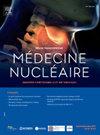Automatic detection of lesions by “artificial intelligence” in [18F]FDG PET/CT in clinical practice: What is the most efficient solution?
IF 0.2
4区 医学
Q4 PATHOLOGY
Medecine Nucleaire-Imagerie Fonctionnelle et Metabolique
Pub Date : 2025-03-01
DOI:10.1016/j.mednuc.2025.01.161
引用次数: 0
Abstract
Introduction
Artificial intelligence (AI) algorithms have recently been commercialized to assist nuclear medicine physicians in lesion detection in clinical practice. The aim of this study was to evaluate the lesion detection performance on [18F]FDG PET/CT by two commercially available AI algorithms using a convolutional neural network (CNN), when used alone or in addition to a human reading.
Materials and methods
151 [18F]FDG PET/CT scans of patients managed for melanoma or lymphoma in 3 French centers were retrospectively analyzed. Lesion detection was performed according to four methods: manually (M1); by using a « PET Assisted Reporting System » (PARS) based on CNN trained on 629 patients with lymphoma and lung cancers, with a detection threshold at SUV 2.5 (M2) or PERCIST-like (M3); and by using a one-step U-net algorithm trained on 4906 patients with multiple neoplasias (M4). All volumes of interest (VOIs) identified by each of the 4 methods were reviewed by an expert consensus. VOIs judged to correspond to neoplastic lesions related to the pathology studied were labeled “true positives” (TP). The sensitivities of detection methods were compared in pairs using Student's paired-sample t-test, as well as sensitivities of automated methods combined with human reading.
Results
A total of 1544 lesions were considered as the reference standard. The respective sensitivities one-step method (M4), PARS with a SUV threshold of 2.5 (M2) and PERCIST-like (M3), and the manual method (M1) were 95.7%, 60.2%, 44.3%, and 76.6%, respectively. When combining M4 with human detection (M1), its sensitivity reached 99.9%, significantly higher than that of any other method alone or combined. M4 reported the highest number (1435) of false-positive VOIs, compared with 837 for M2 and 151 for M3.
Conclusion
The use of some clinically available AI algorithms could provide a robust safety net to physicians for lesion detection on [18F]FDG PET/CT, with more than 99% sensitivity. Its routine use is nevertheless currently limited by its high false-positive rate.
[18F]FDG PET/CT“人工智能”在临床中的病灶自动检测:最有效的解决方案是什么?
人工智能(AI)算法最近被商业化,以协助核医学医生在临床实践中进行病变检测。本研究的目的是通过使用卷积神经网络(CNN)的两种市售AI算法,在单独使用或与人类阅读一起使用时,评估[18F]FDG PET/CT上的病变检测性能。材料和方法[18F]回顾性分析法国3个中心治疗黑色素瘤或淋巴瘤患者的FDG PET/CT扫描。病变检测分为四种方法:手工检测(M1);使用基于CNN的“PET辅助报告系统”(PARS),对629例淋巴瘤和肺癌患者进行训练,检测阈值为SUV 2.5 (M2)或percist样(M3);并使用对4906例多发性肿瘤患者(M4)进行训练的一步U-net算法。4种方法中每一种确定的所有感兴趣量(voi)都经过专家共识审查。判断为与所研究病理相关的肿瘤病变相对应的voi被标记为“真阳性”(TP)。使用学生配对样本t检验对检测方法的灵敏度进行了两两比较,并对自动化方法与人工阅读相结合的灵敏度进行了比较。结果共1544个病灶作为参考标准。一步法(M4)、SUV阈值为2.5 (M2)和类似percist (M3)的PARS法(M3)和手动法(M1)的灵敏度分别为95.7%、60.2%、44.3%和76.6%。当M4与人检(M1)结合使用时,其灵敏度达到99.9%,显著高于其他单独或联合使用的方法。M4报告的假阳性voi数量最多(1435),M2为837,M3为151。结论使用一些临床可用的人工智能算法可以为医生在[18F]FDG PET/CT上的病变检测提供强大的安全网,灵敏度超过99%。然而,由于其高假阳性率,其常规使用目前受到限制。
本文章由计算机程序翻译,如有差异,请以英文原文为准。
求助全文
约1分钟内获得全文
求助全文
来源期刊
CiteScore
0.30
自引率
0.00%
发文量
160
审稿时长
19.8 weeks
期刊介绍:
Le but de Médecine nucléaire - Imagerie fonctionnelle et métabolique est de fournir une plate-forme d''échange d''informations cliniques et scientifiques pour la communauté francophone de médecine nucléaire, et de constituer une expérience pédagogique de la rédaction médicale en conformité avec les normes internationales.

 求助内容:
求助内容: 应助结果提醒方式:
应助结果提醒方式:


